Whenever you are learning how to play chess, the first piece you are taught how to move is the pawn, and that’s for a good reason; they have the simplest moves.
So, how do pawns move in chess? Pawns move forwards only on the same file, they can move one square forwards, but they can also move two squares forwards if it’s their first move. Pawns capture pieces diagonally and have special moves called “en passant.”
So, as you can see, the movement of pawns in chess is not that simple. I think the only really simple piece in chess is the bishop, which does not have any kind of special moves, contrary to pawns, which have three special moves.
Keep reading as I explain how pawns move in chess and the special moves they have.
Pawns in Chess
They are the least valuable on the board, considered the weakest by many, and are often the first pieces to move, and there are 16 of them, outnumbering any other piece.
The tiny pawn may seem like it has little impact on the game, but the truth is that pawns often determine how it is played.
The value of a pawn
A pawn is valued at only one point (some argue that knights are worth 3.5 pawns), a rook is worth 5, and a Queen is worth 9 pawns (while you only have 8!).
This means that pawns are the least valuable pieces in your army, but this is very relative to the position you are playing. Most experienced players know that the value of a pawn is determined by many factors, such as their position, whether they have opposing pawns on the same file, and how supported they are.
A strong pawn in the center is often your stronghold that your pieces will center around for more control over the board, and a passed pawn is often a decisive winning advantage in endgames.
In other words, a pawn can be a lot more valuable than its numerical value.
Now, let’s see how they actually move.
How Pawns move in Chess
The movement of pawns on the chessboard is pretty simple:
- They can move one square forward at any point
- They can move two squares forward if it’s their first move
- If a pawn has moved before, it can not move two squares forwards.
- They can move forwards only, never backward
- Pawns can not jump over other pieces – so if the square
- They can capture pieces diagonally in each direction if those pieces
Okay, now let’s see diagrams that explain this better.
In the diagram below, you can see how, from the starting position, any pawn can move one or two squares forwards.
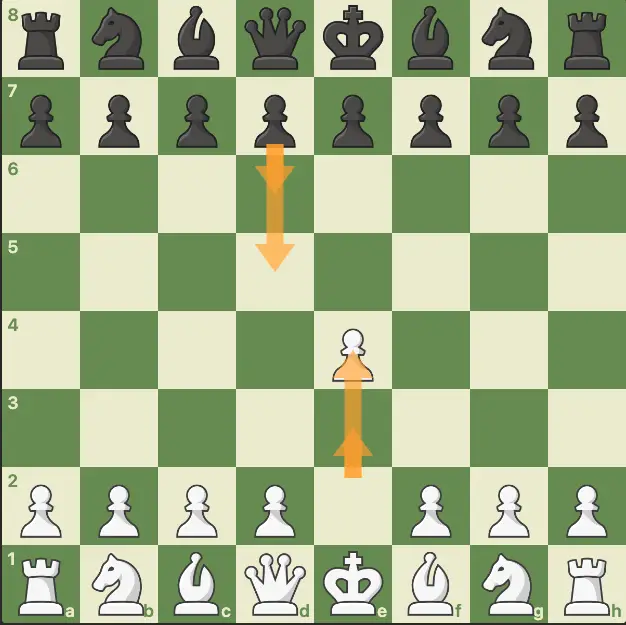
The orange arrows show how white can start with e3 or e4, and e4 is actually the most popular starting move in chess. In response, black can also move any of its pawns one or two squares forwards.
The diagram below shows how can pawns capture:
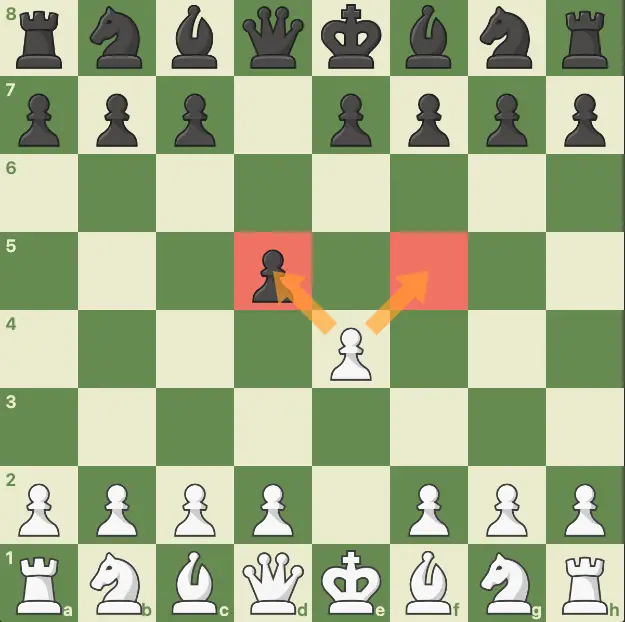
Assuming the first moves of the game went: 1. e4 d5, the white pawn can now capture the black pawn with 2. exd. The e4 pawn also controls the f5 square, so if black had a piece there, white could also capture it.
It’s important to note that now since the e4 pawn has already made its first move, it can now never move two squares in one move again.
It’s also important to note that this is true regardless of whether the pawn moves one or to squares in their first move.
The Special movements of chess pawns
Pawns have three special moves; the first is one we’ve already discussed, which is that they can move two squares for their first move.
The second move is the en passant capture, so let’s explain this further:
En Passant.
En passant is a french term that means “in passing.” En passant is a special move that pawns can make, but in only one situation:
- A pawn must be on the 5th row (of your side)
- The opponent’s pawn must be right on either side of this pawn
- The opponent’s pawn must move two squares forwards for their first move
- This will bring the two pawns side-by-side, and in this case, your pawn can take this pawn.
- However, your pawn does not move to the side to take their pawn
- Instead, your pawn acts as if this pawn was one square back and takes it as if it were a normal pawn-capturing scenario.
- You can only capture en passant on the very next turn to their pawn’s move.
This sounds very confusing, I know! So, let’s see how this is done in action.
Assuming the first few moves in the game played out like this:
- e4 – d5
- e5
We get this situation:
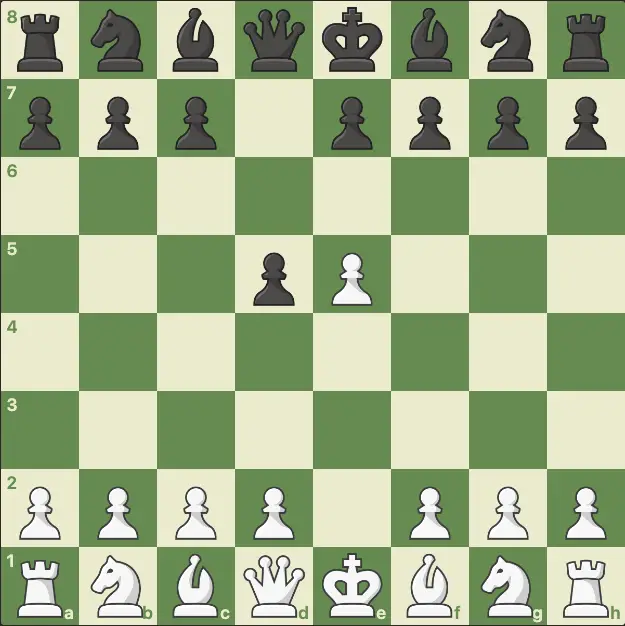
If, in this position, black decides to play 2. … f5, white’s e5 pawn can take it and move to f6 (not f5), as if black had moved their f pawn to f6 and not f5.

Funnily enough, most amateurs and beginners completely forget that pawns actually have this ability and are almost always shocked when someone takes their pawns en passant.
I had a few players that shouted “illegal” when I did it, only for the arbiter to come to the board to tell them that it was perfectly legal and they just had forgotten or did not know about the rules.
Now, let’s talk about the special move of the pawn and the one that actually matters the most: Promotion!
Pawn Promotion
Pawn promotion is simple: if your pawn gets to the other side of the board (the 8th rank if you are playing white and the 1st rank if you are playing black), it can be promoted into any major piece.
This means that your pawn can be promoted to any piece with the exception of a king or a pawn.
Pawns can be promoted into
- Queens (the most popular option for obvious reasons)
- Rooks
- Knights
- Bishops
Pawn promotion is basically what the vast majority of endgames are all about.
Each side will try to promote their pawns. In fact, pawn promotion is the modern way to end a chess game.
A classic chess game from the romantic era is focused on giving a spectacular checkmate, but modern chess games are more strategic – or more civilized, you could say.
A modern chess game is about getting just one pawn advantage over the other side, exchanging as many pieces as you can to get to a favorable endgame, promoting it to a queen, and giving a simple checkmate.
The pawn square
An important concept in promoting pawns is the pawn square. Understanding pawn squares is crucial for playing king and pawn endings, which is the most common type of endgame.
But what is a pawn square? Let’s illustrate this with a diagram:

See the square made with the arrows? This is the white’s pawn square. In this square, black can not catch the white pawn in time if it’s white’s turn, and the pawn will be promoted, but if it’s black’s turn and the black king can step into the square, it can stop it from promoting.
Go ahead, play it on the board and try it out yourself.
Congratulations, now you know everything about how chess pawns move. Now, it’s time to understand some concepts about pawns that will help you use them much more effectively.
Understanding Pawns
Pawns are the simplest pieces to understand in the chess game, but because there are so many of them, they are also a major force on the board and often can control how the game goes.
As with any chess piece, there are a few concepts you need to understand to know how to play a better game. In my experience, there are a few concepts that any chess player must understand to be able to perform exceptionally well in the game; these are:
Pawn Chains
A pawn chain is a line of blocked pawns that are all connected. Pawn chains have heads, which are the most advanced pawns in the chain, and bases, which are pawns at the end of the chain (the ones at the back).
A perfect example of pawn chains is the advanced variation of the french defense:
1.e4 e6 2.d4 d5 3.e5 c5 4.c3 Nc6 5. Nf3 Qb6
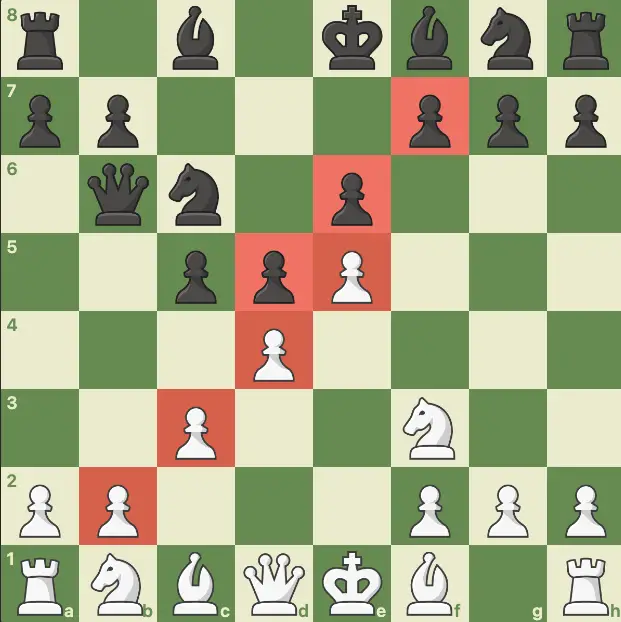
We now see that each side has its own pawn chain, but that white’s pawn chain is clearly stronger than black’s. White’s pawn chain is more advanced and stronger, starting at the b2 pawn and extending all the way to the e5 pawn.
The e5 pawn, in this case, is the head of white’s pawn chain. It’s annoying to black as it takes away the squares f6 from the black knight and the d6 square from black’s bishop.
Black also has his own pawn chain, consisting of the f7, e6, and d5 pawns.
A french defense advanced variation game is often about the control of the center, with white trying to solidify their position by supporting the e5 and d4 pawns and black trying to undermine this chain.
The way to fight against pawn chains is simple; you need to attack the base or try to break down the chain.
This is why black here will focus their forces on the d4 pawn with moves like C5, Qb6, Nf6, and possibly even rerouting the g-knight with Nh6 and then Nf5.
Isolated Pawns
Isolated pawns are pawns that other pawns can not protect. Isolated pawns are often a weakness and a liability since they need constant protection from major pieces.
In the diagram below, the white e4 pawn is an isolated pawn.
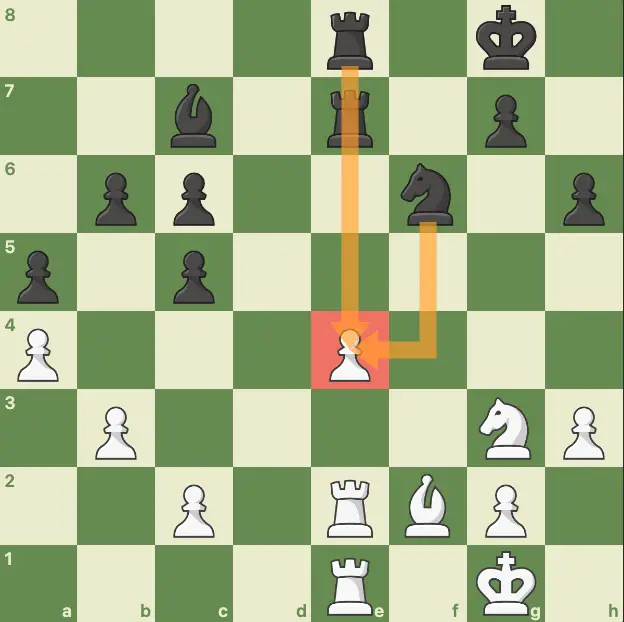
Notice how the whole game is about this pawn? Most white pieces are tied down to protect this pawn, while most black pieces aim right at it.
In most situations, the isolated pawn eventually falls. In the position above, if it’s black’s turn, Bxg3 will win the pawn by removing one of its defenders.
Blocked Pawns (Rams)
Blocked pawns are pawns that can not move because their file is blocked by other pieces. Usually, pawns are blocked by other pawns (whether from their side or the other), but since pawns take diagonally only, they can be blocked by any piece right in front of them.

In the diagram above, you can see how both pawn chains are blocked and can not move.
Doubled Pawns
Doubled pawns are two pawns of the same side that share a file. Doubled pawns are bad for a few reasons:
- They hinder each other’s mobility
- They are slow to move
- They are often weak and sometimes isolated
- They have a weaker influence on the position
In the diagram below, white’s e pawns are doubled, and so are black’s b pawns:

Backward Pawns
Backward pawns are pawns that have been left behind by their fellow pawns and can not move forward without coming under attack or being taken.
In the diagram below, you can see how the white c3 pawn is backward and under heavy attack from all of black’s pieces.

The road to victory here for black is to move one more piece under the attack, which is going to be his king. First, black needs to block this backward completely with Rc4. Then, the black can maneuver their king to the b3 square to put more pressure on the c3 pawn.
Pawns FAQs
Can chess pawns move backward?
Chess pawns can never move backward. They can not move, check, or threaten their side either. Pawns can only move one square forward when taking another piece, with the exception of en passant captures.
Can pawns give a checkmate?
Pawns can checkmate, indeed. Any chess piece, except for the king, can give a checkmate. Some tactical patterns end with a pawn giving a checkmate. Pawns can also give checkmate by discovery when they suddenly move out of the way to allow another piece to be in direct line with the king, checkmating it.
Can pawns take out anything?
Pawns can take out any of the opponent’s pieces except for their king, as the king can not be captured and can only be checkmated.
